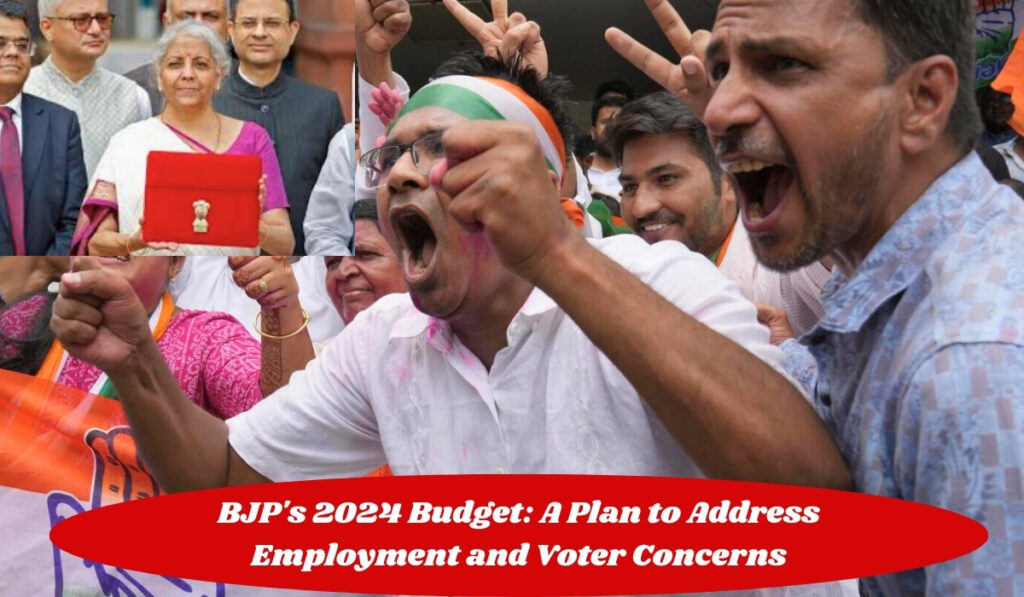The recent budget presented by Finance Minister Nirmala Sitharaman is heavily influenced by the political context, especially the recent elections where the BJP lost its single-party majority. This budget aims to address key concerns, primarily unemployment, and to regain the trust and support of the young voters who played a significant role in BJP’s previous electoral victories.
The Political Context of the Budget
The backdrop of Nirmala Sitharaman’s post-Budget press conference prominently featured the acronym “EMPLOYMENT,” highlighting the primary focus of this budget. The BJP’s recent electoral setback was partly due to the dissatisfaction among voters, especially the youth, regarding the lack of decent-paying jobs. This budget reflects a strategic response to this feedback, with several incentives for both large and small industries to create more jobs.
Focus on Youth Employment
Addressing Youth Unemployment
India’s demographic profile, with a significant proportion of young people, necessitates a focus on employment. Disaffected young voters, many of whom are college-educated, are a political liability. These individuals are less swayed by welfare schemes and more concerned with job opportunities. Recognizing this, the budget places their concerns at the forefront, aiming to win back the youth vote that was crucial in BJP’s 2014 and 2019 electoral victories.
Incentives for Job Creation
The budget introduces unconventional methods for job creation, primarily through incentives for private sector employers. This approach bets on the responsiveness of companies to government nudges, although it remains uncertain how effective this will be. The critical question is whether these measures will result in substantial job creation in the formal sector, a necessity for altering the perception that the Modi government has ignored unemployment.
The Internship Program
A key element of the budget is the introduction of an internship program aimed at providing young people with work experience. However, the political efficacy of this program hinges on whether these internships lead to permanent jobs. If many interns remain unemployed after their internships, the BJP’s political challenge regarding unemployment may persist.
Skilling Programs and MSME Support
Revamping Skilling Programs
The budget builds on previous efforts to enhance skilling programs. While past initiatives have had mixed results, the current budget aims to improve the effectiveness of these programs, thereby offering young voters a better chance at gaining meaningful employment. This could have a significant positive impact politically, provided the programs succeed in their objectives.
Support for MSMEs
The budget’s approach to Micro, Small, and Medium Enterprises (MSMEs) is politically strategic. MSMEs are known for their labor-intensive nature and their potential for job creation. The budget supports MSMEs through a friendlier credit regime, aiming to stimulate employment and garner support from small business owners who are generally sympathetic to the BJP.
Infrastructure Projects and Ally Management
Targeted Infrastructure Spending
The budget allocates capital expenditure for specific projects, particularly in states governed by BJP allies. This approach ensures that funds are spent effectively on infrastructure projects such as roads, bridges, and irrigation systems, which can deliver both politically and economically.
Political Prudent Allocation
This targeted allocation is also fiscally prudent, avoiding the pitfalls of indiscriminate spending and ensuring that resources are directed towards impactful projects. This strategy helps manage political alliances effectively, providing support to allies while maintaining a focus on broader economic development.
Women-Centric Initiatives
Investment in Women and Girls
Recognizing the growing importance of women voters, the budget allocates Rs 3 lakh crore for schemes aimed at women and girls. These initiatives, often implemented through self-help groups, aim to build on the success of previous programs and ensure continued support from this critical demographic.
Political Impact
Women have increasingly become a significant voting bloc, and their support can act as a counterbalance in regions where other voter groups are dissatisfied with the BJP. The budget’s focus on women-centric schemes reflects an understanding of this political reality.
Urban and Middle-Class Considerations
Capital Gains Tax and Income Tax Tweaks
The budget’s impact on the investing classes and the urban middle class is mixed. The increase in the capital gains tax burden and the relatively minor tweaks in income taxes may not be well-received by these groups. However, these are not the primary targets of the current political strategy.
Focus on Lost Votes
The budget’s primary objective is to regain the votes lost in recent elections. This focus on employment and targeted support for key demographics reflects a strategic attempt to address the concerns of disaffected voters and rebuild political support.
Conclusion
The recent budget by Finance Minister Nirmala Sitharaman is a strategic response to the BJP’s recent electoral challenges. By focusing on employment, supporting MSMEs, targeting infrastructure projects, and investing in women-centric initiatives, the budget aims to address key voter concerns and regain lost political ground. The effectiveness of these measures in creating jobs and generating political support will be crucial in determining the BJP’s future electoral prospects.
References:
- Rappler.com
- PAGASA
- Various news and analysis articles on Indian politics and budget strategies

